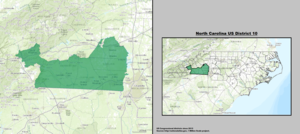Member(Residence) Party Years Cong Electoral history District location District established March 4, 1793 Benjamin Williams (Glendon ) Anti-Administration March 4, 1793 – 3rd Elected in 1793 . Nathan Bryan (Craven County ) Democratic-Republican March 4, 1795 – 4th 5th Elected in 1795 .Re-elected in 1796 .Re-elected in 1796 . Vacant June 4, 1798 – 5th Richard D. Spaight (New Bern ) Democratic-Republican December 10, 1798 – 5th 6th Elected to finish Bryan's term .Also elected in 1798 to the next term . John Stanly (New Bern ) Federalist March 4, 1801 – 7th Elected in 1800 .Redistricted to the 4th district and lost re-election. Nathaniel Alexander (Charlotte ) Democratic-Republican March 4, 1803 – 8th 9th Elected in 1803 .Re-elected in 1804 .governor of North Carolina . 1803–1813 "North Carolina congressional district map (1803–13)" . [ 12] Vacant November 1805 – 9th Evan S. Alexander (Salisbury ) Democratic-Republican February 24, 1806 – 9th 10th Elected to finish his cousin's term .Re-elected in 1806 . Joseph Pearson (Salisbury ) Federalist March 4, 1809 – 11th 12th 13th Elected in 1808 .Re-elected in 1810 .Re-elected in 1813 . William C. Love (Salisbury ) Democratic-Republican March 4, 1815 – 14th Elected in 1815 . 1813–1843 "North Carolina congressional district map (1813–43)" . [ 12] George Mumford (Salisbury ) Democratic-Republican March 4, 1817 – 15th Elected in 1817 . Vacant December 31, 1818 – Charles Fisher (Salisbury ) Democratic-Republican February 11, 1819 – 15th 16th Elected in early 1819 to finish Mumford's term and seated February 11, 1819.Re-elected later in 1819 . John Long (Long's Mil ) Democratic-Republican [ a] March 4, 1821 – 17th 18th 19th 20th Elected in 1821 .Re-elected in 1823 .Re-elected in 1825 .Re-elected in 1827 . Anti-Jacksonian March 4, 1825 – John Giles Jacksonian March 4, 1829 – 21st Elected in 1829 . Abraham Rencher (Pittsboro ) Jacksonian December 2, 1829 – 21st 22nd 23rd 24th 25th Elected December 2, 1829 to finish Giles's term and seated December 7, 1829.Re-elected in 1831 .Re-elected in 1833 .Re-elected in 1835 .Re-elected in 1837 .[ data missing ] Anti-Jacksonian March 4, 1833 – Whig March 4, 1837 – Charles Fisher (Salisbury ) Democratic March 4, 1839 – 26th Elected in 1839 .[ data missing ] Abraham Rencher (Pittsboro ) Whig March 4, 1841 – 27th Elected in 1841 .[ data missing ] District dissolved March 4, 1843 District re-established March 3, 1903 James M. Gudger Jr. (Asheville ) Democratic March 4, 1903 – 58th 59th Elected in 1902 .Re-elected in 1904 .[ data missing ] William T. Crawford (Waynesville ) Democratic March 4, 1907 – 60th Elected in 1906 .[ data missing ] John G. Grant (Hendersonville ) Republican March 4, 1909 – 61st Elected in 1908 .[ data missing ] James M. Gudger Jr. (Asheville ) Democratic March 4, 1911 – 62nd 63rd Elected in 1910 .Re-elected in 1912 .[ data missing ] James J. Britt (Asheville ) Republican March 4, 1915 – 64th Elected in 1914 .[ data missing ] Zebulon Weaver (Asheville ) Democratic March 4, 1917 – 65th Lost contested election. James J. Britt (Asheville ) Republican March 1, 1919 – 65th Won contested election . Zebulon Weaver (Asheville ) Democratic March 4, 1919 – 66th 67th 68th 69th 70th Elected in 1918 .Re-elected in 1920 .Re-elected in 1922 .Re-elected in 1924 .Re-elected in 1926 .[ data missing ] George M. Pritchard (Asheville ) Republican March 4, 1929 – 71st Elected in 1928 .[ data missing ] Zebulon Weaver (Asheville ) Democratic March 4, 1931 – 72nd Elected in 1930 .Redistricted to the 11th district . Alfred L. Bulwinkle (Gastonia ) Democratic March 4, 1933 – 73rd 74th 75th 76th 77th Redistricted from the 9th district and re-elected in 1932 .Re-elected in 1934 .Re-elected in 1936 .Re-elected in 1938 .Re-elected in 1940 .Redistricted to the 11th district . Cameron A. Morrison (Charlotte ) Democratic January 3, 1943 – 78th Elected in 1942 .[ data missing ] Joseph W. Ervin (Charlotte ) Democratic January 3, 1945 – 79th Elected in 1944 . Vacant December 25, 1945 – Sam J. Ervin Jr. (Morganton ) Democratic January 22, 1946 – Elected to finish his brother's term .[ data missing ] Hamilton C. Jones (Charlotte ) Democratic January 3, 1947 – 80th 81st 82nd Elected in 1946 .Re-elected in 1948 .Re-elected in 1950 .[ data missing ] Charles R. Jonas (Lincolnton ) Republican January 3, 1953 – 83rd 84th 85th 86th 87th Elected in 1952 .Re-elected in 1954 .Re-elected in 1956 .Re-elected in 1958 .Re-elected in 1960 .Redistricted to the 8th district . Basil Whitener (Gastonia ) Democratic January 3, 1963 – 88th 89th 90th Redistricted from the 11th district and re-elected in 1962 .Re-elected in 1964 .Re-elected in 1966 . Jim Broyhill (Lenoir ) Republican January 3, 1969 – 91st 92nd 93rd 94th 95th 96th 97th 98th 99th Redistricted from the 9th district and re-elected in 1968 .Re-elected in 1970 .Re-elected in 1972 .Re-elected in 1974 .Re-elected in 1976 .Re-elected in 1978 .Re-elected in 1980 .Re-elected in 1982 .Re-elected in 1984 .U.S. senator . Vacant July 14, 1986 – 99th Cass Ballenger (Hickory ) Republican November 4, 1986 – 99th 100th 101st 102nd 103rd 104th 105th 106th 107th 108th Elected to finish Broyhill's term .Re-elected in 1986 .Re-elected in 1988 .Re-elected in 1990 .Re-elected in 1992 .Re-elected in 1994 .Re-elected in 1996 .Re-elected in 1998 .Re-elected in 2000 .Re-elected in 2002 . Patrick McHenry (Lake Norman of Catawba ) Republican January 3, 2005 – 109th 110th 111th 112th 113th 114th 115th 116th 117th 118th Elected in 2004 .Re-elected in 2006 .Re-elected in 2008 .Re-elected in 2010 .Re-elected in 2012 .Re-elected in 2014 .Re-elected in 2016 .Re-elected in 2018 .Re-elected in 2020 .Re-elected in 2022 . 2003–2013 2003–2013
2013–2017 2013–2017
2017–2021 2021–2023 Static map of 2021-3 congressional district 2023–2025 Pat Harrigan (Hickory ) Republican January 3, 2025 – 119th Elected in 2024 . 2025–present 




























